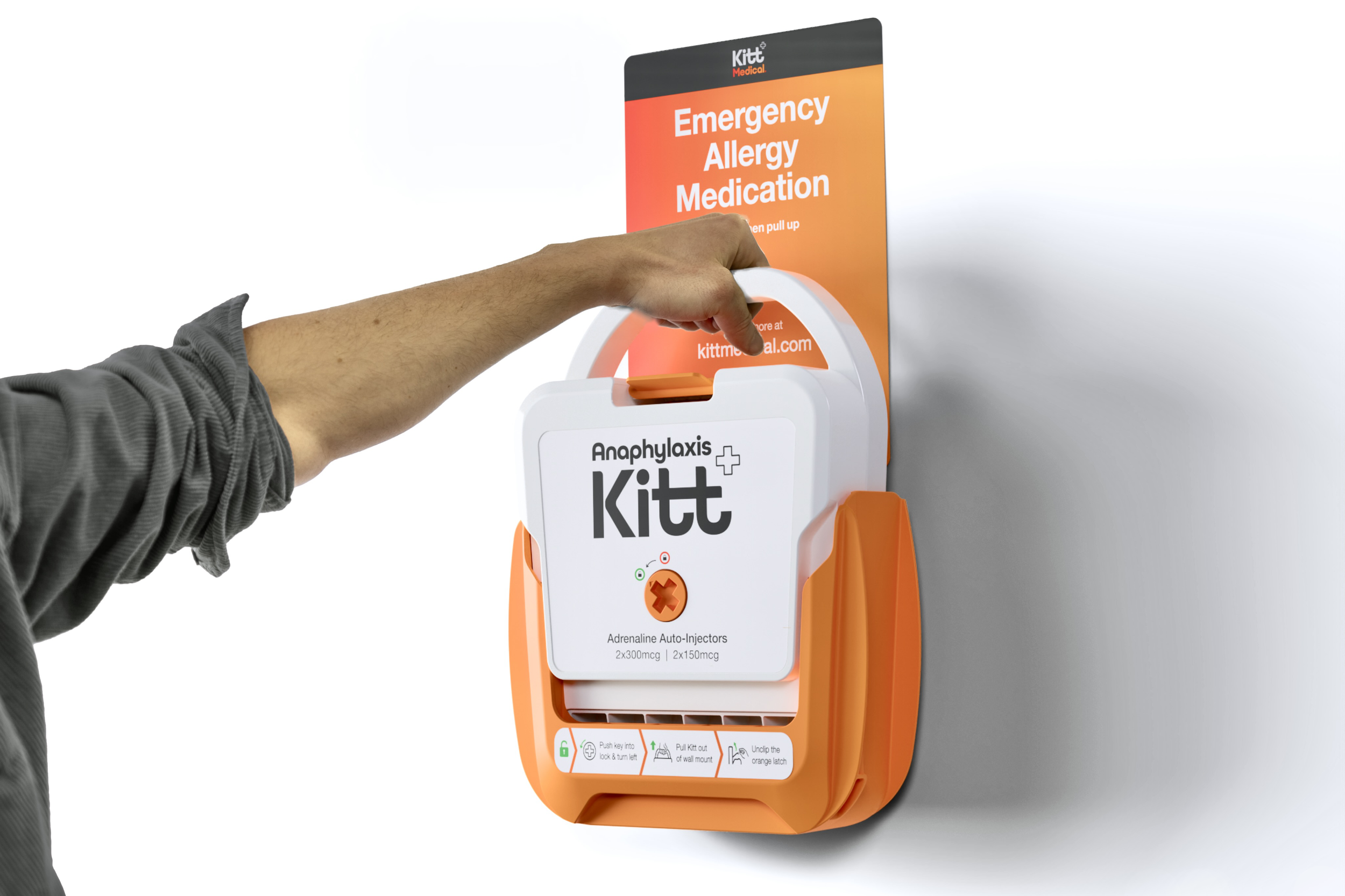A Comprehensive Guide to Emergency Allergy & Anaphylaxis Treatment: How to use an Adrenaline Pen
Allergy is the most common chronic condition in Europe. And while the common symptoms of allergy, such as itchy eyes, runny nose, sneezing, and hives, don’t paint a threatening picture, some types of allergic reactions can be fatal. In fact, according to AllergyUK, up to 20% of people with allergies “struggle daily with the fear of a possible asthma attack, anaphylactic shock, or even death from an allergic reaction.”
Thankfully, during these emergencies, having and knowing how to use an adrenaline auto-injector or adrenaline pen can be a lifesaver.
Severe allergic reactions are often portrayed in media as comedic scenarios. In reality, that’s far from the case.
Understanding Adrenaline Pens
Anaphylaxis is a severe, life-threatening allergic reaction that can happen within minutes to hours. Shortly after being exposed to something you’re allergic to, your pulse may become fast and weak, your blood pressure may drop, and your airways may constrict, making breathing extremely difficult.
Because an anaphylactic reaction may occur within minutes, it pays to always have an adrenaline pen within reach.
An adrenaline pen is a disposable auto-injection device pre-filled with a single dose of epinephrine (adrenaline) - a medicine that can reduce the body’s allergic response. Once administered, adrenaline constricts the blood vessels, which increases the blood pressure, and opens up the airways, allowing the patient to breathe better.
When To Use An Adrenaline Pen
A huge part of knowing how to use an adrenaline pen is understanding that it’s only for emergency treatment - it’s not meant to be administered for mild to moderate allergic reactions. An adrenaline auto-injector must be used immediately when severe signs and symptoms of allergic reaction are present.
Allergic reactions, including anaphylaxis, can occur anytime, anywhere. This is why people who may experience a severe allergy, particularly those with food allergy and allergic asthma, carry two in-date adrenaline auto-injectors with them.
An anaphylactic reaction may occur after:
Being stung or bitten by an insect, such as a bee or wasp
Eating food you are allergic to
Taking medicine you are allergic to
Being exposed to a chemical or object you are allergic to, such as latex
Being exposed to cold temperatures, such as swimming in cold water
when exercising
At times, there may be a combination of causes. There are also cases where people with no previously diagnosed allergies experience anaphylaxis. When the cause or trigger isn’t obvious or apparent, doctors call it idiopathic anaphylaxis. Due to this, it has become increasingly necessary for schools and workplaces to have a supply of adrenaline auto-injectors. Likewise, people must undergo adrenaline pen training to better respond to incidences of anaphylaxis.
Bee sting anaphylaxis can often take people by surprise, and on occasion, can be fatal.
A Step-by-step Guide on How to Use an Adrenaline Auto-Injector
A huge part of adrenaline pen training is knowing how to use it. Remember to use an adrenaline auto-injector immediately after recognizing the signs of anaphylaxis. Even if you’re in doubt, still use the pen without delay.
Step 1: Help the patient lie down.
Help the person lie down on their back. Raise their legs on a chair, pillows, or a couple of folded towels.
If they are having trouble breathing, prop them up with pillows or help them sit up.
If the patient is pregnant, help them lie to their side.
Unconscious patients should be placed in the recovery position - side-lying, with their bottom leg straight and their top leg at a 90-degree angle.
Step 2: Administer the medicine
Adrenaline auto-injectors are colour-coded to easily identify the dose. Ensure the correct one is chosen based on the age and weight of the individual requiring treatment.
Remove the injector from the carrier tube.
Firmly grasp the injector in your fist - the tip where the needle comes out should be pointing down.
Use your other hand to remove the safety release on top.
Administer the medicine. While injectors can deliver the medicine through clothes, be sure to avoid zippers and buttons. Firmly hold the patient's thigh to avoid injection site laceration, then swing the pen and firmly push the tip against the outer thigh until it clicks.
Hold the injector in place, perpendicular to the thigh, for about 10 seconds. The medicine has now been delivered. Massage the injection site for 10 seconds.
Step 3: Call 999
Call 999 and say “anaphylaxis.”
Note that if there are more people in the scene, this step can be done as soon as possible.
999 should still be called even if the patient tells you they feel better, as bi-phasic reactions can occur where symptoms re-occur again after initial treatment.
Step 4: Use the second Auto-Injector if necessary
If the patient’s condition doesn’t improve after 5 minutes, use the second adrenaline auto-injector.
Here's a video and infographic showing how to use an adrenaline pen properly.
Step 5: Stay with the patient until the emergency response arrives
Don’t forget to tell the responders that you have used an adrenaline pen and inform them how many you used (1 or 2). Likewise, show them the used adrenaline auto-injector/s.
An ambulance should always be called when someone experiences anaphylaxis.
Adrenaline alternatives
Currently, there’s no alternative to adrenaline when it comes to emergency treatment for anaphylaxis.
There are three brands of adrenaline pen in the UK market: EpiPen, Jext, and Emerade. While all of them contain adrenaline, there are slight differences in make and instructions. For instance, instead of EpiPen’s orange tip where the needle comes out, Jext has a black tip, and whilst Epipen has a blue safety cap, Jext’s safety cap is yellow, and Emerade’s is white.
Please note that back in May of 2023, there was an order to recall Emerade 150 and 300. Please get in touch with your doctor if you’re using this brand.
Adrenaline Pen Storage and Maintenance
On top of understanding the steps on how to use an adrenaline pen, it’s likewise crucial to know how to store it properly. Keep the following practices in mind:
Keep it out of sight and reach of children.
Store the auto-injectors at 68° to 77° F (20° to 25° C). Do not expose the pens to extreme temperatures. Do not keep it in your car’s glove compartment and never refrigerate it.
Keep away from light and air. Exposure to light and air deteriorates adrenaline. For protection, keep the auto-injectors inside the carrier tube. However, please note that the carrier tube is not waterproof.
Adrenaline pens come with an expiry date. Never use it past its expiration date. If possible, set a reminder or subscribe to an expiry alert service offered by the manufacturer several weeks before it expires. That way, you have adequate time to replace it.
Auto-injectors should not be reused and once used should be replaced immediately.
Regularly check if epinephrine is clear. If it turns pinkish or brownish, it signals deterioration. If the liquid is no longer clear, replace it immediately as well.
Always carry two adrenaline auto-injectors. If one expires or deteriorates be sure to replace that one so you can still have two.
Keeping adrenaline pens in one of our Kitts ensures they’re accessible at all times.
What Kitt Medical Offers
As a fully licensed, regulated, and multi-award-winning anaphylaxis kit service provider, Kitt Medical offers the following:
Anaphylaxis Kitt:
A wall-mounted Kitt with accessories including 4 x keys, emergency key box, and lanyard. (We created our Kitts to look and feel just as important as defibrillators, creating a conversation around allergies that displays their severity and tackles the stigma)
Adrenaline pens:
2x 300mcg and 2x 150mcg adrenaline pens. We provide Jext pens directly through our partnership with the pharmaceutical producer, ALK, and get guaranteed long-shelf-life pens on subscription. (Both the higher and lower doses are provided in every Kitt to cover all ages, with two of each dose in case an extra is needed/the first is used incorrectly)
Also, all adrenaline pen replenishments are taken care of for no extra fees regardless of usage or expiry, saving time and money. (There are 'famous' adrenaline pen stock shortages and issues around expiry dates that we're able to get around via direct supply and exclusive partnership)
Training (+ Software):
Access to our online Kitt Portal for regularly notified Kitt check-up reminders, incident report forms, medication management, and -
Unlimited access to our CPD-accredited online video training that we created in partnership with a certified provider The Allergy Team. All staff members can access this whenever they desire and completions can be tracked with aggregate data.
We run our Kitt service on standard 5-year agreements to mitigate against inflation, reduce the hassle of going through the procurement process on a yearly basis, and because we automatically resend the medication annually.
In conclusion…
Anaphylaxis is a life-threatening allergic reaction, with symptoms often occurring within minutes to hours. Children and adults with severe food and medicine allergies and those with allergic asthma are advised to always carry with them two adrenaline pens.
Adrenaline auto-injectors contain epinephrine, a medicine that can ease fatal allergy symptoms such as lowered blood pressure and difficulty breathing. In the UK, three brands are available: EpiPen, Jext, and Emerade.
While most people who experience anaphylaxis have known allergies, it’s also possible to have no apparent allergy and still have anaphylaxis. For this reason, laws have allowed schools and workplaces to have spare adrenaline auto-injectors that can be administered to anyone who shows the first signs of a severe allergic reaction.
Kitt Medical is an Anaphylaxis Kit Subscription Service that provides supplies of adrenaline auto-injectors to schools and workplaces, giving patients access to life-saving epinephrine during emergencies. To get in touch and find out more about the Kitt service, book a consultation with our team.






